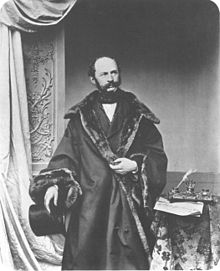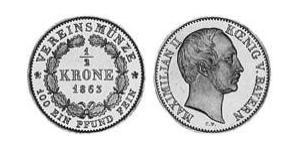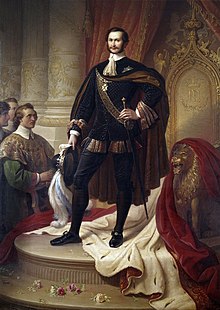| Maximilian II | |
|---|---|
 |
|
| King of Bavaria | |
| Reign | 28 March 1848 - 10 March 1864 |
| Predecessor | Ludwig I |
| Successor | Ludwig II |
| Spouse | Marie of Prussia |
| Issue | Ludwig II of Bavaria Otto of Bavaria |
| House | House of Wittelsbach |
| Father | Ludwig I of Bavaria |
| Mother | Therese of Saxe-Hildburghausen |
| Born | 28 November 1811 Munich |
| Died | 10 March 1864 (aged 52) Munich |
| Burial | Theatinerkirche, Munich |
Maximilian II (28 November 1811 – 10 March 1864) was king of Bavaria from 1848 until 1864. He was son of Ludwig I and Therese of Saxe-Hildburghausen.
Contents
Crown Prince[edit]
After studying at Göttingen and Berlin and travelling in Germany, Italy and Greece, he was introduced by his father into the council of state (1836). From the first he showed a studious disposition, declaring on one occasion that had he not been born in a royal cradle his choice would have been to become a professor. As crown prince, in the chateau of Hohenschwangau near Füssen, which he had rebuilt with excellent taste, he gathered about him an intimate society of artists and men of learning and devoted his time to scientific and historical study.
King[edit]
When the abdication of Ludwig I (20 March 1848) called him suddenly to the throne, his choice of ministers promised a liberal regime.
Although, however, from 1850 onwards his government tended in the direction of absolutism, he refused to become the instrument the clerical reaction, and even incurred the bitter criticism of the Ultramontanes by inviting a number of celebrated men of learning and science (e.g. Geibel, Liebig and Sybel) to Munich, regardless of their religious views.
Maximilian II responded also to the demands of the people for a united German state, by attending the Frankfurt Assembly which intended to create such a state. The progress of the revolution, however, gave him pause. In 1849 an uprising in the Bavarian Palatinate was broken down with the support of Prussian forces. The king strenuously opposed the unionist plans of the Frankfurt Parliament, refused to recognize the imperial constitution devised by it, and assisted Austria in restoring the federal diet and in carrying out the federal execution in Hesse and Holstein. In the aftermath of the failure of the Frankfurt Assembly, Prussia and Austria continued to debate of which monarchy had the inherent right to rule Germany. The dispute between Austria and the Electoral Prince of Hesse-Kassel (or Hesse-Cassel) was used by Austria and its allies (including Bavaria) to promote the isolation of Prussia in German political affairs. This diplomatic insult almost led to war when Austria, Bavaria and other allies moved troops through Bavaria towards Hesse-Kassel in 1850. However, the Prussian army backed down and accepted the principle of dual leadership. This event was known as the Punctation of Olmütz but also known as the "Humiliation of Olmütz" by Prussia. This event solidified the Bavarian kingdom's alliance with Austria against Prussia.

In his German policy Maximilian was guided by the desire to maintain the union of the princes, and hoped to attain this as against the perilous rivalry of Austria and Prussia by the creation of a league of the "middle" and small states - the so-called Trias. In 1863, however, seeing what he thought to be a better way, he supported the project of reform proposed by Austria at the Furstentag of Frankfurt. Attempts by Prussia to reorganize the loose and un-led German Confederation, were opposed by Bavaria and Austria while taking part in its own discussions with Austria and other allies in 1863 in Frankfurt without Prussia and its allies attending. The failure of this proposal, and the attitude of Austria towards the Confederation and in the Schleswig-Holstein Question, disillusioned him; but before he could deal with the new situation created by the outbreak of the war with Denmark he died suddenly at Munich, on 10 March 1864. He is buried in the Theatinerkirche in Munich.
Close to the people and home-loving, he also studied art and customs of the people to promote to set a Bavarian national feeling against the German unification efforts. He supported Bavarian costumes, folk music and customs. In the summers of 1849 and 1855, he traveled in his kingdom. From 24 June to 27 July 1858, he undertook a journey on foot through his country, which began in Lindau. However, because of frequent rain he had to repeatedly use the carried body.
For his government's policy, repeatedly requesting advice of his ministers and the surrounding scholar was characteristic, whereby decisions were often delayed for long. In addition, Maxilmilian often was traveling in Italy and Greece, and work stayed behind for a long time.
Cultural legacy[edit]
Maximilian offered Paul Heyse and other writers from North Germany large stipends. Hans Christian Andersen visited "King Max" (as he called him) in his castle Starnberg, and wrote of him as a young, highly amiable man. The King, having read his novels and fairy tales, let Andersen know that he was deeply impressed by The Improvisatore, En Digters Bazar, The Little Mermaid and Paradisets Have. During the visit Andersen also read The Ugly Duckling.[1] Later Andersen visited the King at the Hohenschwangau castle.
Next to Hohenschwangau Castle also the Hambach Castle was reconstructed from 1844 for Crown Prince Maximilian by August von Voit. In 1849 King Maximilian II instructed the architect Eduard Riedel to redesign Berg Castle in neo-gothic style with several towers and a crenellate.
Maximilian II was the principal of the Maximilianstrasse and the Bavarian National Museum in Munich. Compared to his father, Maximilian preferred a new architectural style with strong reference to the Gothic Revival architecture which would combine the best features of historical models combined with then modern building technology. The neo-gothic Royal Mansion in Regensburg was built for Maximilian 1854-1856, the Royal Mansion in Berchtesgaden and the Royal Villa on Rose Island already in 1853. The hiking path in Upper Bavaria called Maximiliansweg is named after him, as he made a longer hike in the Bavaria alps in the summer of 1858.[2]
Private life and family[edit]
Maximilian was a man of amiable qualities[citation needed] and of intellectual attainments far above the average,[citation needed] but as a king he was hampered by constant ill health, which compelled him to be often abroad, and when at home to live much in the country. The relationship with his father, who also has persisted in his architectural projects after his abdiction, was mostly tense. By his wife, Marie Friederike Franziska Hedwig, daughter of Prince William of Prussia, whom he married in 1842, he had two sons, Ludwig II of Bavaria and Otto of Bavaria, both of whom became king, were declared insane, and deposed.
Styles[edit]
- 28 November 1811 - 13 October 1828: His Royal Highness Prince Maximilian of Bavaria
- 13 October 1828 - 20 March 1848: His Royal Highness Crown Prince Maximilian of Bavaria
- 20 March 1848 - 10 March 1864: His Majesty The King of Bavaria
Ancestors[edit]
References[edit]
| This article needs additional citations for verification. (November 2007) |
- ^ Hans Christian Andersen (1996) [1855]. Mit Livs Eventyr II. Gyldendal. ISBN 87-00-24708-1.
- ^ "Wandern" (in German). Upper Bavaria tourist association (Tourismusverband München Oberbayern). Retrieved 2007-03-11.
![]() This article incorporates text from a publication now in the public domain: Chisholm, Hugh, ed. (1911). Encyclopædia Britannica (11th ed.). Cambridge University Press.
This article incorporates text from a publication now in the public domain: Chisholm, Hugh, ed. (1911). Encyclopædia Britannica (11th ed.). Cambridge University Press.
| Wikimedia Commons has media related to Maximilian II. (Bayern). |
External links[edit]
|
Maximilian II of Bavaria
Born: 28 November 1811 Died: 10 March 1864 |
||
| Regnal titles | ||
|---|---|---|
| Preceded by Ludwig I |
King of Bavaria 1848-1864 |
Succeeded by Ludwig II |
|
||||||||||||||||||||||||||||||||||||||
|
||||||
- 1811 births
- 1864 deaths
- House of Wittelsbach
- Knights of the Golden Fleece
- Kings of Bavaria
- Princes of Bavaria
- Roman Catholic monarchs
- Grand Masters of the Order of Saint Hubert
- Grand Masters of the Royal Order of Saint George for the Defense of the Immaculate Conception
- Burials at the Theatine Church, Munich
- Knights of the Order of Saint Joseph












